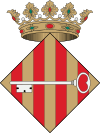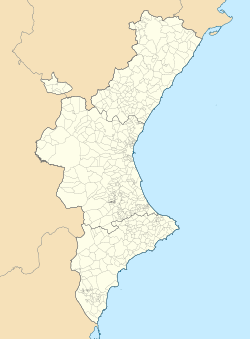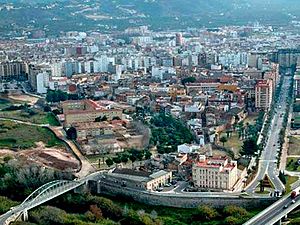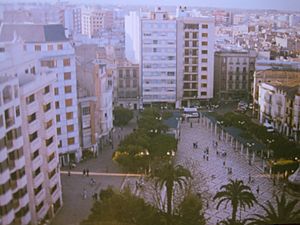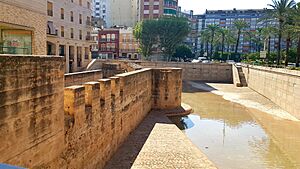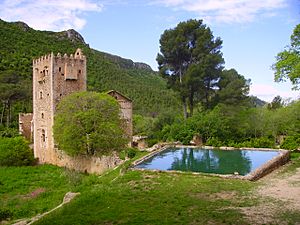Alzira, Spain facts for kids
Quick facts for kids
Alzira
|
|||
|---|---|---|---|
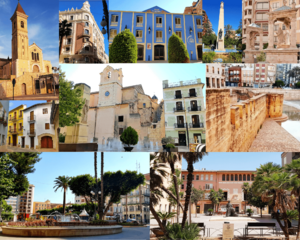 |
|||
|
|||
| Country | |||
| Autonomous community | |||
| Province | |||
| Comarca | Ribera Alta | ||
| Judicial district | Alzira | ||
| Area | |||
| • Total | 110.4 km2 (42.6 sq mi) | ||
| Elevation | 14 m (46 ft) | ||
| Population
(2018)
|
|||
| • Total | 44,393 | ||
| • Density | 402.11/km2 (1,041.5/sq mi) | ||
| Demonyms | Alziran • alzireny, -a (Val.) • alcireño, -a (Sp.) |
||
| Time zone | UTC+1 (CET) | ||
| • Summer (DST) | UTC+2 (CEST) | ||
| Postal code |
46600
46268 (La Garrofera) |
||
| Official language(s) | Spanish and Valencian | ||
Alzira is a lively city and municipality in eastern Spain. It is located in the province of Valencia. Alzira is the main city of the Ribera Alta region. The city is home to about 46,451 people. It is a very important urban area in the province.
Contents
Exploring Alzira's Location
Alzira is found in the province of Valencia. It sits on the left side of the Xúquer river. The city is also on the railway line between Valencia and Alicante.
Climate and Nature
Alzira has a typical Mediterranean climate. This means it is warm, without very hot summers or very cold winters. Rain is not common and can be unpredictable. Sometimes, heavy rains follow long dry periods.
The city is right on the Xúquer river. It also includes the beautiful Murta and Casella valleys. Alzira's area covers about 111 square kilometers.
A Look Back at Alzira's History
Alzira was first built by the Andalusis. They called it Jazīrah Shukr, which means "island along the Xúquer" in Arabic. Later, it was shortened to al-Jazìra, which is where the name Alzira comes from.
Early Prosperity
For over 500 years, Alzira was a busy trading center. This was during the time of the Andalusis. The city had its own local government. It was also a hub for writers, thinkers, and law experts.
Conquest and Challenges
James I of Aragon took control of the city on December 30, 1242.
Because Alzira is right on the Xúquer river, it has faced many big floods. Some of the worst floods happened in 1472, 1590, 1864, 1916, 1982, and 1987.
Historically, Alzira was a walled town. It was surrounded by groves of palm, orange, and mulberry trees. There were also low-lying rice fields nearby. Some people think Alzira might be the Roman town Saetabicula. It could also be the pre-Roman town Sucro. A famous event, the mutiny at Sucro in 206 BC, might have happened near Alzira.
Alzira's Economy
For a long time, farming was the main way people made money in Alzira. Oranges were the most important crop. Local co-operatives helped distribute these oranges.
Modern Industry and Trade
In the 20th century, Alzira's economy changed. It moved from farming to having many different industries. The city also developed a strong business and service sector. Many companies have their main offices here. These include building and publishing companies, factories, and textile and ice cream makers. Alzira has become a very important city for trade. It serves an area with about 300,000 people.
Healthcare in Alzira
Alzira has a large hospital called the Hospital de la Ribera. It has 250 beds and was built in 1999. This hospital uses a special system for healthcare. It connects primary care (like your family doctor) with hospital care. It also uses a single computer system for all services. This way of organizing healthcare is known as the "Alzira model." It has received a lot of attention. The quality of care seems to be much better than in other healthcare systems.
Main Sights to See
- Monastery of la Murta: This monastery has buildings from different time periods. Some parts are from the 11th to 15th centuries. Others are from the 16th and 17th centuries. After it was taken over in the 19th century, a new owner built a manor house. The monastery also has a wall with battlements for defense. Today, you can still see parts of the walls in the garden. Key parts include the new church, the Tower of the Bells, and the ruins of the monastery.
- Alzira Walled Circuit: The walls of Alzira were built around what might have been a river island. This is why its Arabic name means "The Island." The walls had two main purposes. First, they were for defense. Second, they protected the city from floods of the Xúquer river. The river often buried the walls when it flooded. The walled area had a double wall. Today, it surrounds the historic center called la Vila. This area dates back to the Islamic period. Some mosques and baths were once located here. You can still see parts of the walls in two areas: el parc de les muralles and les muralles del Mercat Antic.
- Town Council Hall of Alzira: This building shows a Gothic style from the Crown of Aragon. Its oldest part is from the 16th century. The building mixes Gothic and Baroque styles. It has a square shape and a roof with Arabic tiles. Local workers like stonecutters and carpenters helped build it. Inside, rooms are set around a rectangular hallway. In 1930, it was named an Artistic National Monument.
- Santa Caterina Church of Alzira: This church was rebuilt in the 17th century. It was built on the site of an older mosque. It has a Gothic style with a single main area. The roof is a barrel vault. There are chapels between the buttresses. Above the transept, there is a dome. This church is an example of churches built after the Christian Reconquest.
- Mare de Déu del Lluch Sanctuary of Alzira: This building is in a Neo-Romanesque style. The temple has three main sections with vaulted ceilings. The main chapel has a different type of vault. You enter through a large door that looks Romanesque. Above the door are three big windows and a round window. These let light into the building. To the left, there is a bell tower. It has three parts and a pyramid-shaped top. The middle part has two windows, one above the other, making it look very tall. The top part holds the bells.
- Museum: This museum is located in a noble Gothic-Renaissance house. It is the Municipal Museum of Alzira. It collects cultural items from Alzira and the Ribera Alta region. You can see how people lived from prehistoric times to today. The museum has interesting historical and artistic collections. Its permanent exhibits cover four areas: maps, old artifacts, local customs, and history and arts.
Notable People from Alzira
- Abu Ishaq ibn Ibrahim ibn Abu al-Fath, a poet from the Andalusi period
- Raúl Albentosa, a footballer
- Adrián Campos, a Formula One driver and founder of Campos Racing
- Mónica Carrió, a weightlifter
- Lorenzo Carrió, a weightlifter
- Jorge Martínez, a motorcycle racer
- Elisa Ramírez, an actress
See also
 In Spanish: Alcira para niños
In Spanish: Alcira para niños



